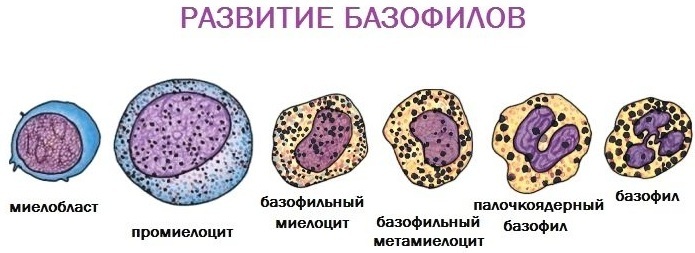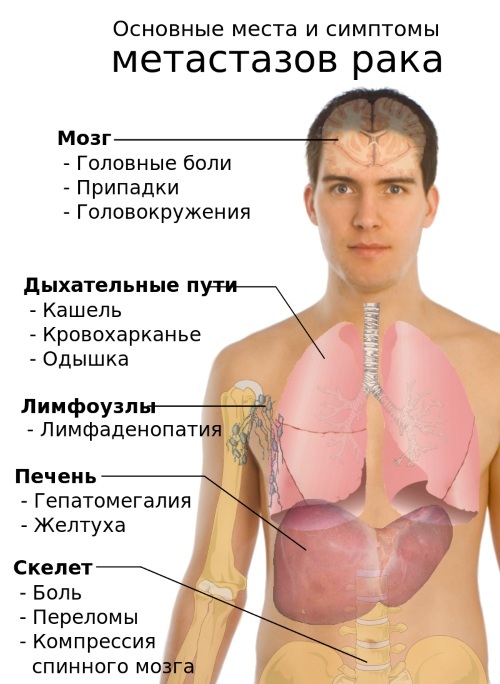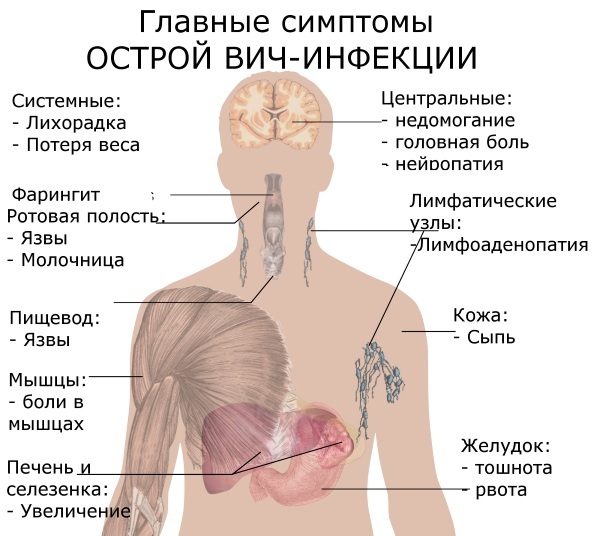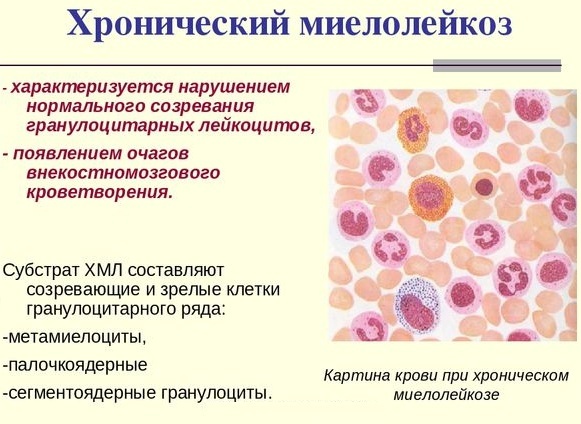Myelocytes should not be present in the blood of a healthy person. If their presence is noted in the analysis, this becomes a serious reason for a more detailed diagnosis.
Record content:
- 1 What are myelocytes?
-
2 Types of myelocytes
- 2.1 Basophils
- 2.2 Eosinophils
- 2.3 Neutrophils
-
3 Causes of the appearance in the blood in adults, children
- 3.1 Acute infectious processes
- 3.2 Tumors
- 3.3 Tissue necrosis
- 3.4 Anemia
- 3.5 Poisoning
- 3.6 Radiation
- 3.7 Rare, severe infectious processes
- 3.8 Taking some medications
- 3.9 Pregnancy
- 3.10 Increased physical activity
- 4 Danger to the body
- 5 Diagnostics
- 6 How to properly prepare for testing?
- 7 What not to do?
-
8 Deciphering the results of blood tests
- 8.1 Myelocyte rate
- 8.2 Increased performance
- 9 What influences the result?
- 10 Treatment
- 11 Forecast
- 12 Blood test videos
What are myelocytes?
Any blood cell develops on the basis of a precursor. Before a mature cell enters the peripheral circulatory system, it goes through several intermediate stages from a stem cell to a fully matured cytological structure.
Myelocytes are immature precursors one of the varieties of leukocytes - granulocytesdetermining their full development. Myeloid forms are an important stage in the formation of adult white blood cells.
When a pathogen enters the body, mature leukocytes fight against it. However, in the case of a complex and long-lasting disease, their supply is depleted, and then unripe forms are thrown into the bloodstream.
The body loses strength, its immune system weakens. The bone marrow begins to actively produce new cells that do not have time to mature. This is what causes the appearance of myelocytes in the blood.
Types of myelocytes
There are three types of myelocytes: basophilic, eosinophilic, and neutrophilic. At the final stage of the formation of the last mature variant, three types of granular are formed from immature predecessors. granulocytes of the myeloid series: basophils, eosinophils and neutrophils that perform specific functions and differ in concentration.
| Granulocyte type | Concentration in blood% |
| Basophils | 0 — 1 |
| Eosinophils | 0,5 — 5 |
| Neutrophils | segmented 47 - 72 stab 1 - 6 |
Basophils
These are the largest cells in the white row. Basophils are responsible for the preservation of the body's defenses, blocking toxins and animal poisons that penetrate the skin. They take part in the metabolism of the skin, prevent the spread of foreign particles, including allergens.
They take part in the processes of blood coagulation and phagocytosis. Where basophils die in the tissues, redness, swelling and itching appear.
Eosinophils
They have the ability to phagocytosis, but their main mission is to fight parasitic infections. The structure of the outer membrane allows eosinophils to adhere to helminth eggs and dissolve them.
In addition, they eliminate the remnants of microorganisms, regulate the release of histamine, and prevent excessive reactions of the body to foreign proteins. On the way to the lesion, eosinophils penetrate the walls of the vessel into the tissue and resist the adhesion of platelets, thereby participating in the prevention of thrombosis.
Neutrophils
The largest group of blood cells produced by the bone marrow. Their main task is to fight all types of bacterial and fungal infections. They have several modifications and are microphages. These are the first immune cells to rush to foreign organisms, consume them and destroy them through the action of enzymes and antimicrobial substances.
The body produces up to 100 billion neutrophils per day, but they have a very short life span. After 8-12 hours, the cells self-destruct, preventing the accumulation of inflammation in the body. This is the very first discharge of purulent wounds.
Causes of the appearance in the blood in adults, children
Myelocytes in a blood test are an abnormality. Normally, they should not be present in the peripheral blood. Their presence always indicates the development of a pathological process in the body. There are a lot of factors that cause a violation of the hematopoietic process. Of these, the most typical are distinguished.
Acute infectious processes
Any infection - bacterial, viral or fungal - causes the activity of a large number of neutrophils. In this way, the body tries to eliminate pathogens of pathology and protect the affected area from healthy tissues. In the process of hematopoiesis, a failure occurs, and immature individuals enter the peripheral circulatory system.
No special treatment is required in such cases. It is enough to identify the cause of the underlying pathology and carry out the correct treatment. After about 2 weeks, the maturation process of cytological units returns to normal.
Tumors
The neglected pathological processes in malignant neoplasms are especially dangerous. Cancer cells, growing, take away nutrition from healthy cells, provoking their death.
Dead cells enter the bloodstream. The body's immune system sends cleaners to the affected area. As the tumor grows, the bone marrow ceases to cope with the load, the cleaning cells do not have time to mature, and their immature predecessors are thrown into the blood. Treatment should also be aimed at eliminating the pathological process.
Tissue necrosis
Cell death is observed with significant tissue damage that occurs, for example, with a heart attack, gangrene or extensive burns. There is a need for the fastest cleansing of the blood from toxins.
As a rule, neutrophils and basophils maturing normally are not enough, the body activates the production of new leukocytes, and the formation of white blood cells fails cells.
After surgical or medical removal of dead cytological structures, bone marrow returns to the normal rate of production of mature cells, and the concentration of myelocytes in the blood is reduced to zero.
Anemia
Myelocytes in a blood test can appear when a deficiency of trace elements is found in the body and vitamins, in particular iron and B vitamins, necessary for the full maturation of cells blood.

In this case, the person develops glandular or megaloblastic anemia. The process of hematopoiesis first slows down, the number of mature cells decreases, and then their deficiency begins to be replenished by immature individuals. Myelocytes, replacing the lack of mature cells, aggravate the pathological process.
Treatment in such cases should be intensive, with the introduction of very large doses of iron and vitamins into the body.
Poisoning
Toxins resulting from poisoning dramatically change the blood picture. The hematopoietic system begins to work much more intensively. Most often this happens with household ethanol poisoning, taking synthetic psychoactive substances.
Treatment in such situations is reduced to stopping the intake of alcohol and synthetic drugs, detoxification of the body using special solutions and drugs. Cleansing the body gradually normalizes the reproduction of mature granulocytes.
Radiation
Even a small dose of radioactive exposure has a detrimental effect on the maturation of blood cells. The affected bone marrow begins to intensively release immature myelocytes into the bloodstream.
To normalize the processes of hematopoiesis, it is necessary to urgently eliminate the cause and consequences of radiation exposure. In such cases, iodine preparations are used. Additionally, prescribe nutritional therapy rich in proteins and fats.
Rare, severe infectious processes
Myelocytes are always present in the blood test in the case of long-term chronic infections, including which include tuberculosis, HIV, AIDS, severe forms of syphilis, herpetic lesions and other similar pathology.
The blood picture during these diseases constantly shows a high concentration of myelocytes. The more neglected the situation, the more difficult it is to restore the process of hematopoiesis, and therefore, to increase immunity. Therefore, you need to start treatment as early as possible.
Taking some medications
Non-steroidal anti-inflammatory drugs, drugs of the glucocorticoid group have a negative effect on hematopoiesis. In addition, changes in the blood picture are possible after chemotherapy.
To change the situation, it is enough to replace the drug with a less safe for the immune system. The solution to this issue cannot be taken without consulting a doctor.
Pregnancy
During pregnancy, at about 26 - 29 weeks, the process of hematopoiesis increases sharply due to the growth of the fetus. The body of the expectant mother perceives this as a pathology, and myelocytes are released into the blood. The permissible concentration of immature cells should not exceed 2-3%.
According to experts, this situation does not affect the health of the woman and her child. But, in any case, when myelocytes appear, a thorough examination is necessary for exacerbation of chronic diseases or the development of the first signs of oncological pathology.
Immediately after the birth of a baby, a certain amount of immature granulocytes may be present in his blood, which disappear if the baby is healthy. Otherwise, the presence of young cells indicates the activation of processes in the bone marrow, which responds to the occurrence of pathological transformations.
The cause of the release of myelocytes in a newborn can be congenital heart disease, dehydration, indomitable vomiting, and weak immunity. In older children, increased hematopoiesis is due to the development of pathological processes, which are based on factors identical to adults.
Increased physical activity
In some cases, young leukocytes are detected in the blood of patients actively practicing high physical activity. The reason for this deviation from the norm is increased blood circulation and, as a result, the active formation of metabolites.
As a rule, the concentration of immature cells in such cases does not increase significantly, and returns to normal a few hours after the decrease in the load. This type of violation does not require medical treatment.
Danger to the body
After identifying the cause of the presence of immature cells in the bloodstream and eliminating it, the myelocytes themselves are not removed from the tissues. It is necessary to carry out special treatment aimed at removing incompletely formed cells from the body.
If this is not done in a timely manner, a change occurs in the cellular composition of the blood - leukocytosis. The consequence of such changes can be leukemia and leukemia. The risk of vascular pathologies (dystonia) may sharply increase.
The presence of myelocytes in the bloodstream has a negative effect on immunity and can provoke the activation of hereditary blood pathologies, which include:
- anemia;
- myeloid leukemia;
- hemoglobinopathy;
- eosinophilia and other diseases of the hematopoietic system.
Diagnostics
It is impossible to detect myelocytes in a blood test of a healthy person. There are only a few exceptions. A small number of young leukocytes in pregnant women in the third trimester of pregnancy (no more than 3%) should not cause serious concern.

Experts believe that this is the expected reaction of the body to the transfer of maternal data to the fetus. To rule out the likelihood of infections, it is recommended to re-test the blood, and then repeat it every week before childbirth.
The presence of white immature cells (up to 0.5%) in the blood of a newborn in the first 4 days after birth is also considered a relative norm. But already on the fifth day, this may indicate a pathological process. In older children, young forms of leukocytes report increased immunity, which requires careful examination.
If myelocytes appear in the plasma of an adult, it means that an inflammatory process occurs in the patient's body, which immune cells can no longer cope with. First of all, it is necessary to identify the possible cause of the release of immature cytological structures into the plasma.
A complete blood count is the beginning of a long research journey. The patient is referred for an appointment with a hematologist, under whose supervision he must undergo a number of special examinations.
Initially, the doctor conducts a survey, finds out the general condition of the patient, clarifies complaints, identifies symptoms and puts forward hypotheses about the alleged pathological process.
The patient is then advised to have an extended blood count to check for a possible infection. The next stage is biochemical tests showing the presence or absence of anemia.
Regardless of the results, the patient is referred for an examination of the digestive tract in order to exclude disturbances in the work of the gastrointestinal tract. If cancer is suspected, they are referred for MRI and CT. Moreover, in the case when the localization of the probable tumor process is unknown, the entire body is completely scanned.
In addition, a visual examination of the skin is carried out to detect inflammation, necrotic areas, purulent and other injuries. After a thorough examination and diagnosis, the patient is prescribed treatment, the effectiveness of which will depend on the restoration of the hematopoiesis process.
How to properly prepare for testing?
The accuracy of laboratory tests depends on the patient's preparation for the procedure.

To do this, you need to fulfill several elementary requirements:
- Considering that the sampling of biomaterial is usually carried out in the morning, it is better to do with a light dinner the day before.
- At least 8 hours should pass from the last meal to the time of testing.
- It is not recommended to drink any drinks in the morning; in exceptional cases, a glass of water is allowed.
- You should not drink alcoholic beverages a week before the tests. It is also necessary to adjust the diet, exclude fatty, fried, spicy, salty foods and sugary carbonated drinks from the diet.
In addition, it is recommended to limit smoking, and immediately before sampling the biomaterial, you must not smoke for at least an hour.
What not to do?
Before taking blood, you should exclude intense physical activity. Sometimes even brisk walking or climbing stairs can cause shortness of breath and increased heart rate. In this case, you should rest, restore breathing and normal heart function. You cannot get tested after visiting the physiotherapy room, X-ray and ECG.
Compliance with simple rules will allow you to avoid significant errors in the research results.
Deciphering the results of blood tests
Usually, after 2-3 days, the patient receives a form with the results of laboratory tests, where the percentage of the concentration of myelocytes and other forms is indicated.
Myelocyte rate
Since immature cells are localized in the bone marrow, they should not be present in the peripheral blood.
Ideally, the rate of myelocytes and other young cells in the blood plasma should be zero.
Increased performance
The presence of immature forms in the blood fluid indicates the presence of a pathological process in the body. Moreover, if the values of the concentration of myelocytes are within 5%, we can talk about a non-hematological pathogen.
10-15% speak about the presence of myeloproliferative diseases, including:
-
chronic myeloid leukemia - the bone marrow produces an increased number of leukocytes;

- essential thrombocytosis - there is an excessive number of platelets;
- polycetamia characterized by a high level of red blood cells, leading to thickening of the blood fluid;
- idiopathic myelofibrosis - abnormal cells replace bone tissue.
All of these diseases, progressing, can turn into acute leukemia.
Most often men after 40 years of age suffer from myeloproliferative diseases. Less commonly, diseases occur in women, in young people under the age of 20, and extremely rarely in children.
What influences the result?
The test results significantly affect the correct diagnosis and the effectiveness of subsequent treatment.
The reliability of laboratory tests depends on many factors, including:
- pregnancy, phase of the menstrual cycle;
- stressful situations, emotional stress;
- taking medications;
- diet, including fasting;
- SPA - procedures in the form of a sauna and a bath.
Some factors that negatively affect the accuracy of laboratory research, the interested patient is able to eliminate himself. In other cases, the attending physician should be warned, and sometimes the analysis should be postponed to another time.
Treatment
Myelocytes in a blood test indicate the presence of pathogenic processes in the body, as well as borderline conditions in the form of allergic reactions or imbalance of nutrients.
Therefore, the actions of doctors should be aimed at determining the cause provoking a deviation from the norm. After more in-depth research and confirmation of the diagnosis, an individual treatment plan for the underlying disease is drawn up.
Revealing an inadequate reaction of the body to medications requires their urgent cancellation and the selection of more suitable medications. After new appointments, regular monitoring of leukocytes and their immature forms in the peripheral blood picture should be carried out for some time.
Disturbances in the hematopoietic system caused by an insufficient amount of nutrients are eliminated through the selection of special diets and vitamin-mineral complexes.
There are no special techniques aimed at removing excess structures from the bloodstream. After carrying out special therapy, and eliminating the causes provoking a violation of the processes of hematopoiesis, the composition of the blood returns to normal.
Forecast
The duration of treatment and its effectiveness depend on the causes of the disorder. In some cases, the process of hematopoiesis is restored on its own, it is enough to eliminate the factors having a negative effect: reduce physical activity, establish a regimen and diet, give up harmful habits. In other situations, a simple therapy solves the problem.
More serious factors include severe chronic diseases, including hematological ones, requiring lifelong medication and regular medical supervision. Oncological processes require special attention. The earlier they are detected, the higher the chance of a favorable prognosis and complete cure.
Despite the fact that myelocytes in the blood fluid are abnormal, by themselves they do not cause any harm to the body. At the same time, their presence in a blood test may indicate very serious pathologies that require immediate medical intervention.
Blood test videos
UAC norm:



